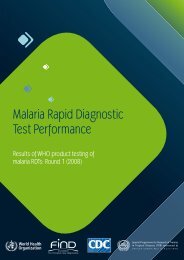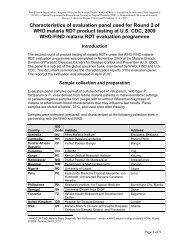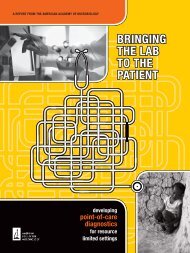MGIT TM Procedure Manual - Foundation for Innovative New ...
MGIT TM Procedure Manual - Foundation for Innovative New ...
MGIT TM Procedure Manual - Foundation for Innovative New ...
Create successful ePaper yourself
Turn your PDF publications into a flip-book with our unique Google optimized e-Paper software.
d. Cross-contamination<br />
Section II: <strong>Procedure</strong> <strong>for</strong> Primary Isolation<br />
Cross-contamination of mycobacteria from specimen to specimen is also known in<br />
mycobacteriology laboratories. Usually it happens during the processing of specimens,<br />
especially at the time when a NaOH-NALC solution is added to the specimen or when a<br />
buffer is added to the tubes. Aerosol generation or splashing during the addition causes<br />
cross-contamination by contaminating the next tube or by contaminating the reagent stock<br />
solution. Touching the lip of the specimen tube with the reagent container during pouring or<br />
adding of the reagent may also lead to high contamination. Sometimes stock solution of a<br />
reagent gets contaminated with mycobacteria commonly found in water (M. gordonae, M.<br />
xenopi). Aliquoting small quantities reduce the chances of cross-contamination. In the event<br />
of a cross-contamination episode, all reagents, equipment and biosafety cabinets must be<br />
thoroughly checked.<br />
3. Sub-culturing a positive <strong>MGIT</strong> tube<br />
It is always helpful to subculture a <strong>MGIT</strong> tube positive <strong>for</strong> mycobacteria on an LJ slant. At<br />
the time positive mycobacterial growth is detected, there is sufficient biomass to use this<br />
growth <strong>for</strong> making a smear, per<strong>for</strong>ming drug susceptibility testing, or per<strong>for</strong>ming other tests<br />
such as species identification. However, growth on solid medium is important <strong>for</strong><br />
observation of colony morphology and chromogenicity, <strong>for</strong> biochemical testing, and<br />
speciation, or <strong>for</strong> a future reference. For subculture, inoculate approximately 0.1-0.2 ml of a<br />
well mixed positive <strong>MGIT</strong> broth on an LJ medium. This is especially important if <strong>MGIT</strong> is<br />
used as a stand-alone system. All subcultures should be incubated at 37ºC + 1ºC and be<br />
examined periodically until good growth is detected.<br />
4. Identification of isolated mycobacteria<br />
Tentative differentiation may be made by the following observations:<br />
a. Rate of growth. Generally, M. tuberculosis, M. bovis and, to some extent, M. kansasii<br />
are slow growers and take a longer time to turn positive in a <strong>MGIT</strong> tube as compared to<br />
other mycobacteria (N<strong>TM</strong>).<br />
b. In liquid medium growth, M. tuberculosis appears granular, while growth of most N<strong>TM</strong><br />
does not show flakes or granules; rather it <strong>for</strong>ms uni<strong>for</strong>m slight turbidity (except M.<br />
kansasii).<br />
c. Smear made from a positive <strong>MGIT</strong> broth also helps in tentative differentiation of M.<br />
tuberculosis complex from other mycobacteria. Cultures belonging to the TB complex<br />
<strong>for</strong>m typical clumps and serpentine cords while other mycobacteria appear as loose,<br />
smaller clumps and cording or single cells. M. kansasii may be difficult to differentiate<br />
because its morphology is closer to M. tuberculosis. 67 The identification of isolates<br />
grown in <strong>MGIT</strong> tube by molecular methods such as AccuProbe® (GenProbe Corp.) has<br />
been reported with good results. 57, 68, 69, 70 According to published reports, AccuProbe<br />
testing of positive specimens can be per<strong>for</strong>med within 24 hours of confirmation of<br />
<strong>MGIT</strong> <strong>TM</strong> <strong>Procedure</strong> <strong>Manual</strong> 33


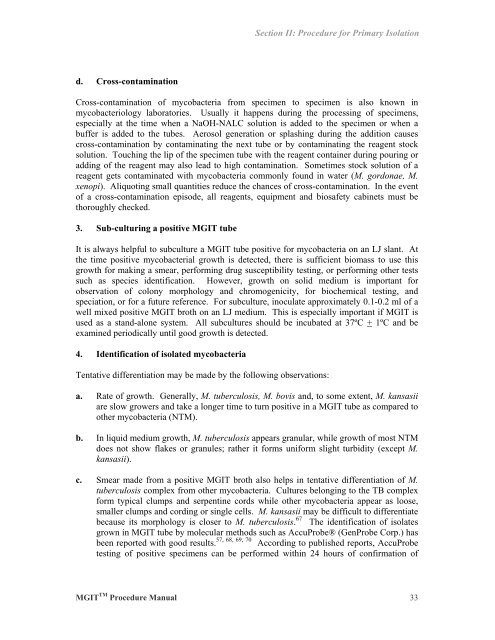

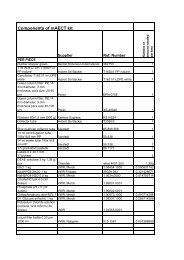
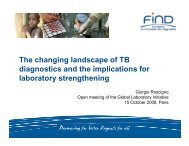
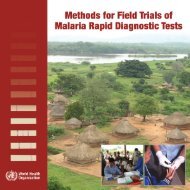
![Download in English [pdf 2Mb] - Foundation for Innovative New ...](https://img.yumpu.com/49580359/1/184x260/download-in-english-pdf-2mb-foundation-for-innovative-new-.jpg?quality=85)

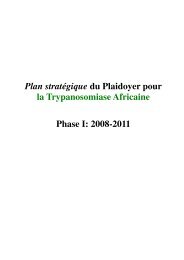
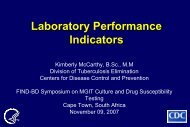
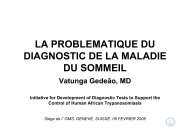
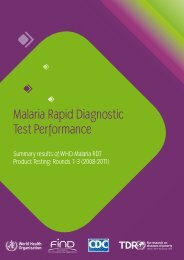
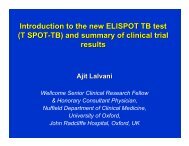
![New laboratory diagnostic tools for tuberculosis control [.pdf]](https://img.yumpu.com/43339906/1/190x135/new-laboratory-diagnostic-tools-for-tuberculosis-control-pdf.jpg?quality=85)
